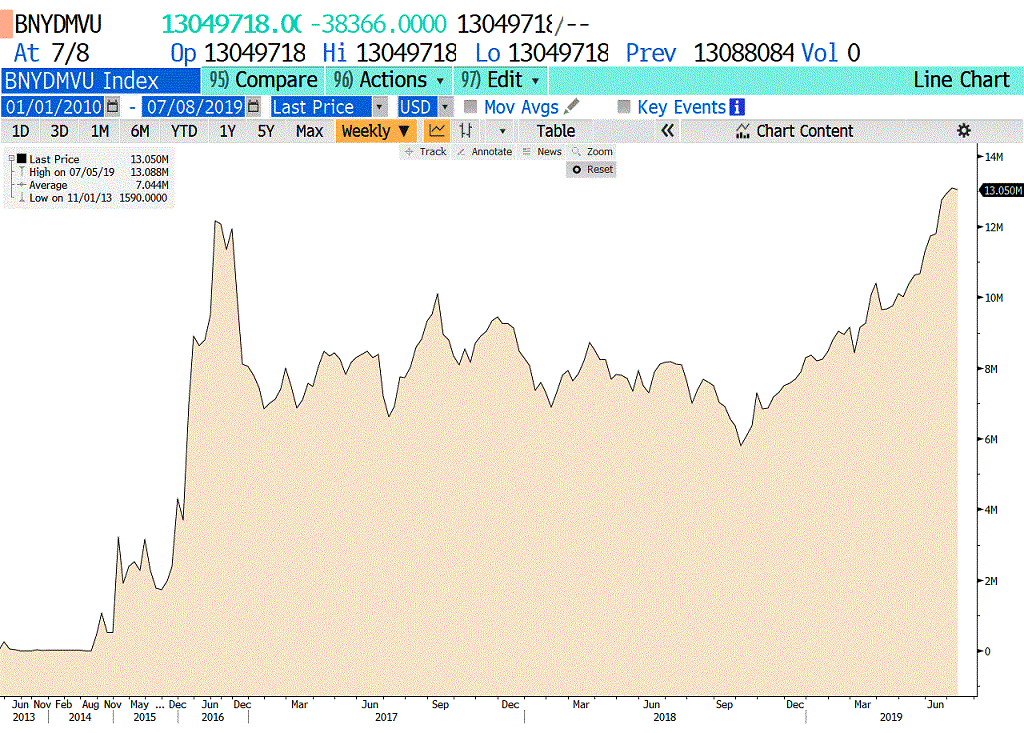Strange moves in global fixed income markets are indicating rough seas ahead, notes Mike Larson.
The musical “Hamilton,” includes a song with the lyrics, “world turned upside down.” It refers to the radical changes everyone will face after the British lose the Battle of Yorktown near the end of the Revolutionary War.
Those words could just as easily refer to what’s happening in the global bond market these days. In fact, we’ve entered something I refer to as the bond market Twilight Zone.
Just consider some of the things going on in this kooky fixed income environment:
- Bonds with 100-year maturities are soaring in value. Everyone seems to be selling them, from higher-risk countries like Argentina and Mexico to lower-risk nations like Austria. And every investor seems to be buying them. Result: They’re generating gains of 19% or more so far this year, even better than the S&P 500.
Never mind that Argentina has a long and storied history of defaults. Or that Austria wasn’t even a country in its current form just over a century ago. Investors are throwing money at them left and right.
- In France, the entire yield curve is negative out to around 10 years. In Germany, it’s almost 20 years. In Switzerland, it’s 40 years.
- Then there's Greece, where 10-year bonds, which yielded 30 percentage points more than U.S. 10-year Treasuries in the early 2010s, now yield just 0.12 percentage points more.
Yes, I’m talking about Greece. The nation that needed $375 billion in bailouts from the European Commission, European Central Bank and International Monetary Fund not too long ago. The market is now assigning its bonds a yield roughly in line with bonds issued by Uncle Sam.
- A handful of European “junk” bonds — bonds issued by companies so troubled they can’t earn investment-grade ratings — have now joined the negative-yield parade. A recent Bloomberg tally found 14 euro-denominated junk bonds offering less than zero, including those issued by Nokia, Altice France and Axalta Coating Systems.
All told, more than $13 trillion in bonds of all kinds from all corners of the world now sport negative yields. That’s a fresh record, higher than we saw at the previous peak in 2016.

Even here in the United States, look at where bonds are trading. The 30-year Treasury was recently yielding just 2.58% and 10-year Treasury notes were yielding 2.07%. Those are the lowest yields we’ve seen since right around President Trump’s election in November 2016 despite an attempted breakout to new highs by the major stock market averages.
Weird? You bet it is! It clearly stems from fresh talk of central bank “stimulus” – including a potential Federal Reserve rate cut later in July and more deeply negative rates or additional quantitative easing from the European Central Bank.
Never mind that we have several years of evidence from Japan, Europe and elsewhere that this so-called stimulus doesn’t work in terms of spurring sustainable growth and inflation. That won’t stop policymakers from throwing more “monetary spaghetti” at the wall to see what sticks.
I’ll leave the debate over how ridiculous that is to others. My job is to help you profit from the market environment we have, not the one I wish or think we should have. With that in mind, I see a few ways to capitalize on this environment.
First, it’s a great reason to buy gold and gold miners. Gold yields 0%, but that’s better than the negative-whatever you can get on $13-trillion-and-counting worth of bonds.
The recent gold rally is just the start of a new bull market in the metal – one that’s worth profiting from. You can get started with something as simple as the SPDR Gold Shares (GLD).
Second, it’s proof that the global economy is slowing and recession risk is rising. After all, investors wouldn’t be plowing their money into long-term bonds if they were worried about accelerating growth and rising inflation. Doing so would be the financial kiss of death because those forces cause bond prices to plummet. My recommendation? Stick with stocks that do best at the tail end of economic expansions and the beginning of recessions. Think lower-volatility, dividend-paying issues like utilities, select REITs, and consumer staples. The Utilities Select Sector SPDR Fund (XLU) is a good bet in this environment.
Third, intermediate-term Treasuries and funds that invest in them are likely to benefit from a coming recession. And they’re likely to win if global interest rates continue to sink inexorably into the quicksand, dragging U.S. yields down with them.
I recently recommended a couple of different ways to profit in Safe Money. But if you aren’t quite ready to join me, then at least consider something like the iShares 7-10 Year Treasury Bond ETF (IEF).
And, buckle up. This journey into the Twilight Zone isn’t going to be smooth. It’s going to be bumpy. But I’ll do my best to guide you through it in the weeks and months ahead.
You’ll find my favorites in the Safe Money Report.





















